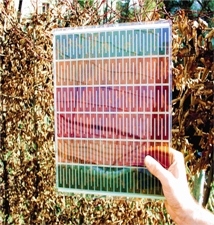Window Power
The next building material to generate solar power may be windows. In a dye-sensitized solar cell, dye molecules attached to nanoscale titania particles are held between two panes of glass; the dye absorbs light and releases electrons, which are harvested by the titania. The basic concept was invented 15 years ago by Michaël Grätzel, chemistry professor at the École Polytechnique Fédérale de Lausanne in Switzerland. Now, the technology is in limited production by Konarka, a company based in Lowell, MA, and will soon be more widely available. “The normal configuration has glass on both sides and can be made to look like a colored glass,” Grätzel says. “This could be used as a power-producing window or skylights or building facades. The wall or window itself is photovoltaically active.” This could give a whole new meaning to the term “power windows.”

Keep Reading
Most Popular
Large language models can do jaw-dropping things. But nobody knows exactly why.
And that's a problem. Figuring it out is one of the biggest scientific puzzles of our time and a crucial step towards controlling more powerful future models.
How scientists traced a mysterious covid case back to six toilets
When wastewater surveillance turns into a hunt for a single infected individual, the ethics get tricky.
The problem with plug-in hybrids? Their drivers.
Plug-in hybrids are often sold as a transition to EVs, but new data from Europe shows we’re still underestimating the emissions they produce.
Stay connected
Get the latest updates from
MIT Technology Review
Discover special offers, top stories, upcoming events, and more.